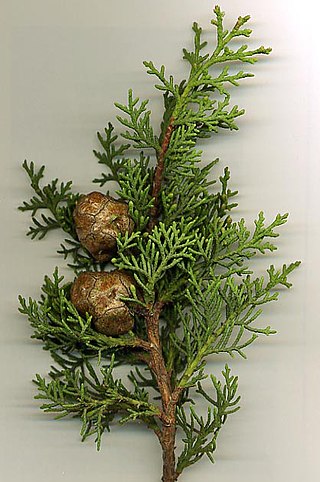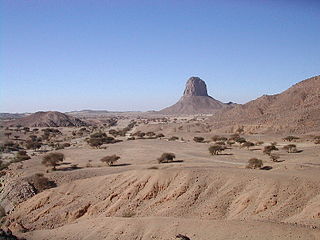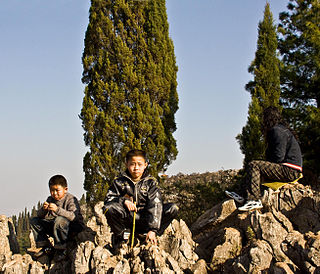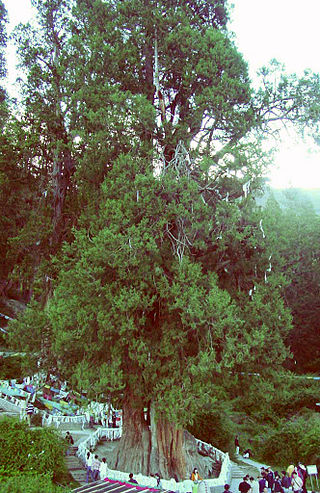
In botany, apomixis is asexual development of seed or embryo without fertilization. However, other definitions include replacement of the seed by a plantlet or replacement of the flower by bulbils.

Bedgebury National Pinetum at Bedgebury, Kent, in the United Kingdom, is a recreational and conservational arboretum managed by Forestry England that was established as the National Conifer Collection in 1925 and is now recognised as the most complete collection of conifers on one site anywhere in the world. The collection has over 10,000 trees growing across 320 acres (1.3 km2), including rare, endangered and historically important specimens. Bedgebury National Pinetum conducts conservation work, is home to some 56 vulnerable or critically endangered species, and houses five National Plant Collections.
Cypress is a common name for various coniferous trees or shrubs of northern temperate regions that belong to the family Cupressaceae. The word cypress is derived from Old French cipres, which was imported from Latin cypressus, the latinisation of the Greek κυπάρισσος (kyparissos). Cypress trees are a large classification of conifers, encompassing the trees and shrubs from the cypress family (Cupressaceae) and many others with the word cypress in their common name. Many cypress trees have needle-like, evergreen foliage and acorn-like seed cones.

Cupressaceae is a conifer family, the cypress, with worldwide distribution. The family includes 27–30 genera, which include the junipers and redwoods, with about 130–140 species in total. They are monoecious, subdioecious or (rarely) dioecious trees and shrubs up to 116 m (381 ft) tall. The bark of mature trees is commonly orange- to red-brown and of stringy texture, often flaking or peeling in vertical strips, but smooth, scaly or hard and square-cracked in some species.

The West Saharan montane xeric woodlands is an ecoregion that extends across several highland regions in the Sahara. Surrounded at lower elevations by the largely barren Sahara, the West Saharan montane xeric woodlands are isolated refuges of plants and animals that can survive in the higher humidity and lower temperatures of the highlands.

Cupressus arizonica, the Arizona cypress, is a North American species of tree in the cypress family Cupressaceae, native to the southwestern United States and Mexico. Populations may be scattered rather than in large, dense stands.

Cedrus atlantica, the Atlas cedar, is a species of tree in the pine family Pinaceae, native to the Rif and Atlas Mountains of Morocco, and to the Tell Atlas in Algeria. A majority of the modern sources treat it as a distinct species Cedrus atlantica, but some sources consider it a subspecies of Lebanon cedar.

The Arboretum & Botanic Garden at the University of California, Santa Cruz, is located on the campus of the University of California, Santa Cruz, in the United States.

Cupressus pygmaea, the Mendocino cypress or pygmy cypress, is a taxon of disputed status in the genus Cupressus endemic to certain coastal terraces and coastal mountain ranges of Mendocino and Sonoma Counties in northwestern California. It is a variable tree, and closely related to Cupressus abramsiana and Cupressus goveniana, enough to sometimes be considered conspecific with them.

Cupressus guadalupensis, the Guadalupe cypress, is a species of cypress from Guadalupe Island in the Pacific Ocean off western North America.

Cupressus atlantica, the Moroccan cypress, is a rare coniferous tree endemic to the valley of the Oued n'Fiss river in the High Atlas Mountains south of Marrakech in western Morocco. The majority are old, with very little regeneration due to overgrazing by goats, and they are critically endangered.

The Santa Cruz cypress is a species of North American tree within the Cypress family. The species is endemic to the Santa Cruz Mountains within the Santa Cruz and San Mateo counties of west-central California. The U.S. Fish and Wildlife Service listed the species on the Endangered Species Act in 1987 due to increasing threats from habitat loss and disruption of natural forest fire regimes. In 2016, the conservation status of the Santa Cruz cypress changed to Threatened. The cited reasoning was a decrease in threats against their habitat.

Cupressus lusitanica, the Mexican cedar or cedar-of-Goa, is a species of cypress native to Mexico and Central America. It has also been introduced to Belize, Costa Rica and Nicaragua, growing at 1,200–3,000 metres (3,900–9,800 ft) altitude.

Cupressus duclouxiana, known commonly as the Chinese cypress or Yunnan cypress, is a species of conifer in the cypress family, Cupressaceae. It is endemic to China, where it is known from Yunnan and Sichuan. It grows in deep river gorges. Its habitat is mountain forest where it occurs alongside the Sikang pine and various oaks, chinquapins, and chestnuts.

Cupressus gigantea, the Tibetan cypress, is a species of conifer in the family Cupressaceae in Asia. C. gigantea was previously classified as a subspecies of Cupressus torulosa because of their similar morphological characteristics and close distribution, but have since been genetically distinguished as separate species.

Cupressus sargentii is a species of conifer in the family Cupressaceae known by the common name Sargent's cypress. It is endemic to California, where it is known from Mendocino County southwards to Santa Barbara County. This taxon is limited to the Coast Range mountains. It grows in forests with other conifers, as well as chaparral and other local mountain habitat, usually in pure stands on serpentine soils. It generally grows 10 to 15 meters tall, but it is known to exceed 22 meters. On Carson Ridge in Marin County, as well as Hood Mountain in Sonoma County, the species comprises a pygmy forest of trees which do not attain heights greater than 240–360 cm due to high mineral concentrations in the serpentine soil.

The Arboretum de Villardebelle is an arboretum specializing in conifers located in Villardebelle, Aude, Languedoc-Roussillon, France.

Cupressus stephensonii is a species of conifer known as the Cuyamaca cypress, and is endemic to Southern California. It has been classified as Hesperocyparis stephensonii. It was previously listed as Cupressus arizonica subsp. stephensonii and Cupressus arizonica var. glabra.
Neoendemism is one of two sub-categories of endemism, the ecological state of a species being unique to a defined geographic location. Specifically, neoendemic species are those that have recently arisen, through divergence and reproductive isolation or through hybridization and polyploidy in plants. Paleoendemism, the other sub-category, refers to species that were formerly widespread but are now restricted to a smaller area.
Androgenesis occurs when a zygote is produced with only paternal nuclear genes. During standard sexual reproduction, one female and one male parent each produce haploid gametes, which recombine to create offspring with genetic material from both parents. However, in androgenesis, there is no recombination of maternal and paternal chromosomes, and only the paternal chromosomes are passed down to the offspring. The offspring produced in androgenesis will still have maternally inherited mitochondria, as is the case with most sexually reproducing species.



















